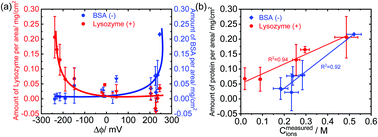Surface charge dominated protein absorption on hydrogels†
Abstract
Soft tissue engineering requires antifouling materials that are biocompatible and mechanically flexible. Conventional hydrogels containing more than 70 wt% water are thus promising antifouling material candidates. However, some hydrogels are difficult to apply in internal body organs because of undesirable protein absorption on their surfaces. Due to the lack of an effective method for observing the true charge densities of hydrogels, the reason why electrostatic interactions dominate protein absorption behavior remains unclear. In this work, we adopt the microelectrode technique (MET) to study the electrical potentials of hydrogels with negative, positive, and neutral potentials and demonstrate the protein absorption behaviors on those hydrogels. The results show that MET is an effective method to obtain the surface charge densities of various hydrogels. Furthermore, the amounts of absorbed proteins on the gels were quantified with respect to the charge densities of the hydrogels. The results indicate that electrostatic absorption is quantitatively dominated by a combination of hydrogel charge density and overall protein charge. Based on the knowledge obtained in this work, the effects of hydrogel surface charges on protein absorption can be better understood. Thus, the results are expected to promote the application of hydrogels in tissue engineering.



 Please wait while we load your content...
Please wait while we load your content...